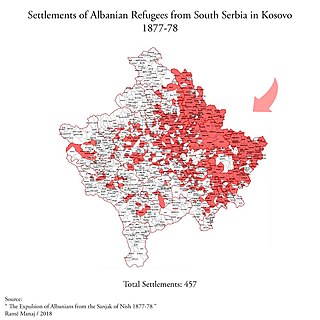
Prokuplje is a city and the administrative center of the Toplica District in southern Serbia. As of 2022 census, the municipality has a population of 38,054 inhabitants.

Kuršumlija is a town and municipality located in the Toplica District of the southern Serbia. It is situated near the rivers Toplica, Kosanica and Banjska, southeast of Mount Kopaonik and northwest of Mount Radan. As of 2022 census, the municipality has a population of 15,905 inhabitants.
Muhaxhir and Muhaxher are Ottoman Albanian communities that left their homes as refugees or were transferred, from Greece, Serbia and Montenegro to Albania, Kosovo and to a lesser extent North Macedonia during and following various wars.
Albanians in Serbia are a recognized national minority in Serbia. According to the 2022 census, the population of ethnic Albanians in Serbia is 61,687, constituting 0.93% of the total population. The vast majority of them live in the southern part of the country that borders Kosovo and North Macedonia, called the Preševo Valley. Their cultural center is located in Preševo.
Rašica is a village in the municipality of Blace, Serbia. According to the 2002 census, the village has a population of 183 people.
Đake is a village in the municipality of Kuršumlija, Serbia. According to the 2002 census, the village has a population of 83 people.
Dedinac is a village in the municipality of Kuršumlija, Serbia. According to the 2002 census, the village has a population of 124 people.
Ljuša is a village in the municipality of Kuršumlija, Serbia. According to the 2002 census, the village has a population of 109 people.
Sekirača is a village in the municipality of Kuršumlija, Serbia. According to the 2002 census, the village has a population of 29 people.
Kaludra is a village in the municipality of Prokuplje, Serbia. According to the 2002 census, the village has a population of 80 people.
Mala Plana is a village in the municipality of Prokuplje, Serbia. According to the 2002 census, the village has a population of 608 people.
Velika Plana is a village in the municipality of Prokuplje, Serbia. According to the 2002 census, the village has a population of 666 people.
Jasenica (Albanian:Jashanica) is a village in the municipality of Žitorađa, Serbia. According to the 2002 census, the village has a population of 989 people.
Lukomir is a village in the municipality of Žitorađa, Serbia. According to the 2002 census, the village has a population of 960 people.
Toponica is a village in the municipality of Žitorađa, Serbia. According to the 2002 census, the village has a population of 329 people.
The Sanjak of Niš was one of the sanjaks of the Ottoman Empire and its county town was Niš. It was composed of the kazas of Niš (Niş), Pirot (Şehirköy), Leskovac (Leskofça), Vranje (İvranye), Kuršumlija (Kurşunlu), Prokuplje (Ürküp) and Tran (Turan).
Mekiš is a village situated in Doljevac municipality in Serbia.
Popovac is a village situated in Niš municipality in Serbia.

The expulsion of the Albanians (1877–1878) refers to events of forced migration of Albanian populations from areas that became incorporated into the Principality of Serbia and Principality of Montenegro in 1878 after their initial expulsion from 1830–1876. These wars, alongside the larger Russo-Ottoman War (1877–78) ended in defeat and substantial territorial losses for the Ottoman Empire which was formalised at the Congress of Berlin. This expulsion was part of the wider persecution of Muslims in the Balkans during the geopolitical and territorial decline of the Ottoman Empire.

Acts of violence were committed against ethnic Serbs, primarily by Albanians, during the final stages of the Ottoman Empire and their control of parts of the Balkans.




